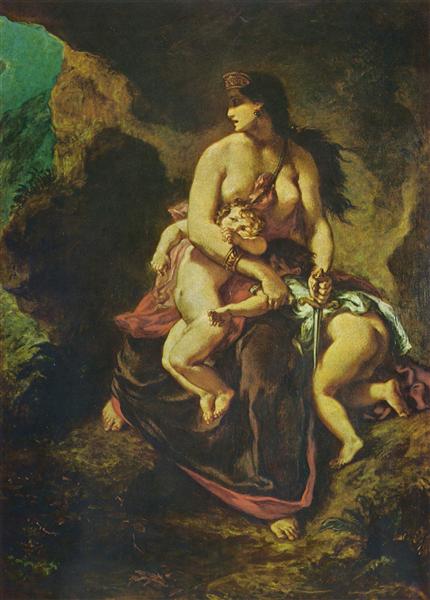Description
Romantic master Eugène Delacroix's 1838 painting "Medea" stands as a powerful manifestation of the emotional complexity and drama inherent in his subjects. In this work, Delacroix explores the figure of Medea, the infamous sorceress from Greek mythology, whose story is marked by love, betrayal and revenge. The choice of Medea as a subject reflects the artist's fascination with intense human passions, a hallmark of his output.
The composition of the work is dynamic and charged with tension. On the canvas, Medea is placed in the foreground, allowing the viewer to immediately connect with her powerful presence. The figure, at once majestic and tragic, is dressed in richly textured attire that accentuates her status and the intensity of her character. Delacroix employs a masterful use of curved lines that guide the viewer's gaze towards the central figure, creating a sense of movement and depth. The darkly shadowed background contrasts with the character's luminosity, intensifying her isolation and emphasizing her internal conflict.
Colour plays a crucial role in the work. Delacroix uses a vibrant palette that alternates between warm and cool tones, creating dramatic contrast. Medea's skin is illuminated by an almost supernatural light, suggesting the duality of her nature: simultaneously fascinating and terrifying. The crimson and gold colours of her clothing evoke both nobility and the passion and fury of her spirit, while the blue and black of the background invite the darkness of her impending vengeance.
Medea's eyes are particularly intriguing; her gaze, filled with determination and pain, hints at a story of betrayal that is about to unfold. This depiction of emotionality aligns with the Romantic ideal in art, where intense expressions and dramatic narratives dominate. Delacroix, in this sense, captures the emotional climax of the myth with great effectiveness, making Medea a figure of empathy despite her somber actions.
Not only does the work resonate within the context of Greek mythology, but it also connects to the legacy of Romanticism, a movement that championed individuality and emotion over reason. This exploration of the supernatural and the psychological lies at the core of Delacroix’s work and distinguishes him from his neoclassical contemporaries, who often prioritised formality and idealisation.
Delacroix, like other Romantic masters, is drawn to the intersection of art and literature. The work can be seen as a commentary on the character of Medea as portrayed in the tragedies of Euripides, where the extremes of female passion are explored. This approach nuances her depiction, making the viewer see Medea not just as the villain of the story, but as a woman broken by betrayal.
"Medea" is a testament to Delacroix's ability to capture the emotional outburst at a crucial moment, using compositional and chromatic elements to invite reflection on the nature of revenge, loneliness and the power of women in classical narrative. This work is a cornerstone in the exploration of Romantic art and remains relevant in its ability to evoke the subjective intensity of human experience.
KUADROS ©, a famous painting on your wall.
Hand-made oil painting reproductions, with the quality of professional artists and the distinctive seal of KUADROS ©.
Painting reproduction service with satisfaction guarantee. If you are not completely satisfied with the replica of your painting, we will refund 100% of your money.

